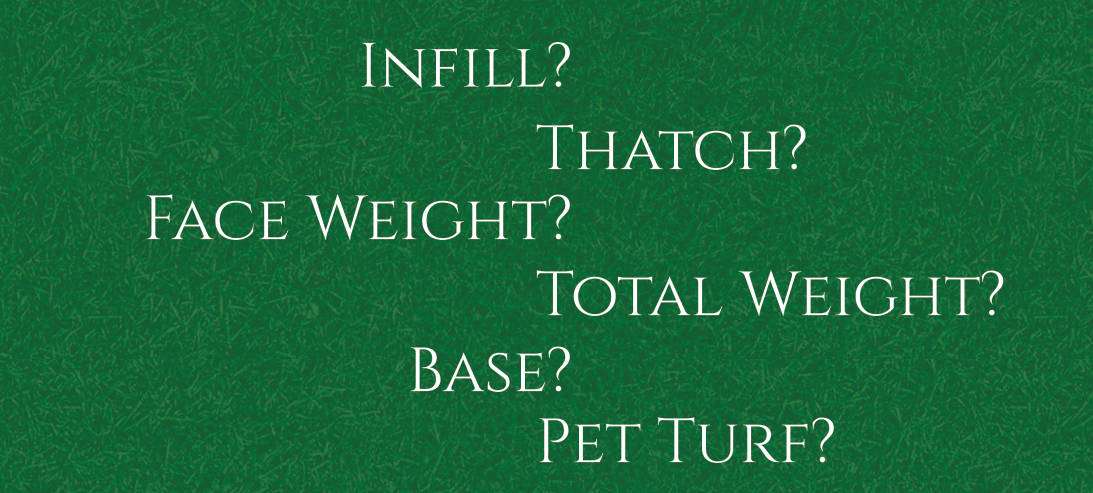Artificial Turf Jargon Explained
We all know that industry jargon can be confusing and annoying as a consumer. While jargon is helpful when communicating within an industry, it can really turn away people without a technical background on the subject. When it comes to artificial turf installation, there are definitely words and phrases used that can be hard to understand if you’ve never gone through the turf purchasing process before. Not understanding what something means on your quotes can make choosing the right company rather difficult. We are here to make your quote gathering process a bit easier by explaining what some of the artificial turf industry jargon means.

INFILL
When a company or quote mentions infill, they’re talking about the sand (or sand-like material) that goes on top of the artificial turf. A common misconception about infill is that it goes underneath the turf. That is not the case. Infill is poured over the turf and is then worked into the turf with a brush. The infill is important to any artificial turf installation as it is what keeps the turf weighted down and the blades resilient. Without the infill, the turf would move around and would be completely matted down.
There are several different options of infill that can be used depending on the turf application. Read our “Different Types of Infill for Artificial Turf” blog post to learn more about the different options of infill. The pounds per square foot of infill needed for a job is determined by the ounces of the turf product. Be sure to compare how many pounds per square foot of infill a company is going to install for your installation. The more the better to ensure ultimate resilience.
FACE WEIGHT VS TOTAL WEIGHT
Product weight is marketed as either “face weight” or “total weight” – both of which are measured in ounces per square yard. If not clearly labeled, you should be sure to ask if the listed weight of the artificial turf product is face weight or total weight.
The face weight of a product is the weight of the fibers used to manufacture the artificial turf pile but does not include the weight of the backing. The total weight of a product includes both the weight of the artificial turf backing and the fiber face weight.
Face weight is more important than total weight because it does not really matter what the weight of the backing is when you are looking for a full, luscious lawn. The face weight will determine how durable and full your lawn is going to be. We’ve seen competitors market their products using total weight, which can be very misleading when trying to accurately compare quotes between turf companies.
THATCH
You may hear a company throw around the word “thatch” every so often. Here is everything you need to know:
- Thatch is shorter fake grass blades that are usually a different color from the primary, taller blades.
- These fibers are usually a bit “curlier” than the primary blades.
- The main purpose of thatch is to make the product look more realistic by imitating the dying blades that occur in real grass.
- The color of thatch is usually a tan, brown, yellow, or green.
In addition to providing a realistic texture to turf, thatch also plays a role in the density of the turf. This is because thatch is included in face weight. In general: products without thatch are much more dense at the top of the pile. Products with thatch have a more balanced density from top to bottom. Sometimes thatch is short and sometimes it is long, which changes the overall appearance and softness of the turf at different levels.
BASE
A common misconception about artificial turf installation is that we simply install the turf over dirt. If any company says this is how they’ll be installing your project, RUN!
The “base” is what a company will install and compact underneath the artificial turf. A durable, drain-able base underneath the artificial turf is very important. Decomposed granite and road bases are the most commonly used products for a base. The best practice for base underneath a turf installation is to compact 4” of it to ensure a more durable area with better drainage. However, the amount of base used is completely dependent on turf application and property attributes.
If you are comparing quotes from multiple companies that list different amounts of base, you should ask both companies how they came to their number. As explained above, the safest bet is a 4″ base depth, however a skilled installer will be able to tell when less base is needed (like if your lawn has a natural slope) which can save you money. This is one of the reasons why working with a very experienced team is important!
PET TURF
If you are not familiar with the different types of artificial turf, you may scratch your head when someone asks you if you are interested in a pet turf product. A pet turf is simply just a pet friendly artificial turf product. A pet turf will have a permeable backing to allow for drainage. If you do not have a permeable backing when you have pets, the liquids will have nowhere to drain to. The liquids will then get absorbed into the turf product itself and will cause of foul odor.
CONTACT US
We are here to make this installation process an easy breeze for you. We can clear up any questions you may have. Contact us today for a free quote for installation!